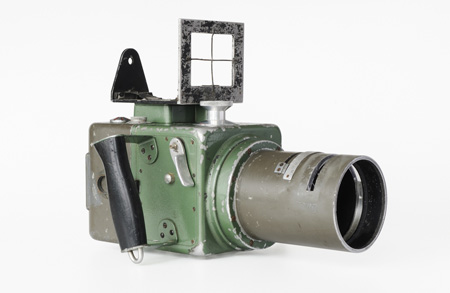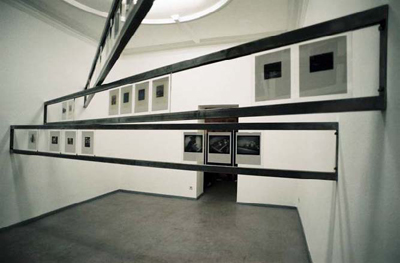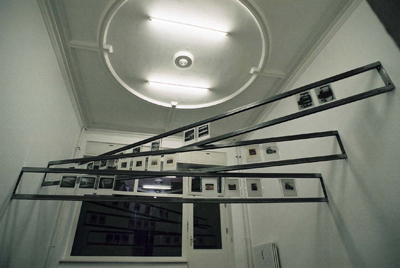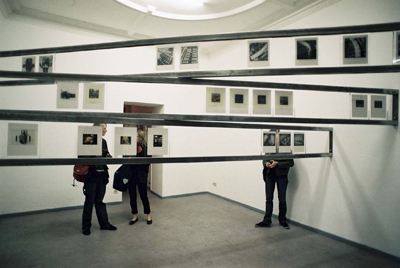Susanne Kriemann – One Time One Million (Migratory Birds / Romantic Capitalism)

*** German version below ***
Opening Friday, September 18, 2009, 7 p.m.
Duration September 19 – November 21, 2009
In her solo exhibition for uqbar, Susanne Kriemann (*born in Erlangen in 1972, lives in Berlin and Rotterdam) presents the artwork One Time One Million (Migratory Birds/Romantic Capitalism) (2009), which was first shown at the Stedelijk Museum Bureau Amsterdam and appears here in a new installation developed especially for the uqbar space.
The point of departure for the photography book and exhibition project is a Hasselblad aerial camera from 1942, which Susanne Kriemann employs as both a camera and a historic trigger to examine aspects of the history of photography and the notion of migration as well as their relationship to modernism’s utopia of city planning. This photographic journey through the twentieth century is divided into chapters with archival images and chapters with Kriemann’s own photographs. These shots are formally interconnected in their use of strategies of classical photography such as a bird’s-eye view or Rodtschenko’s familiar diagonal. The content of Kriemann’s project contrasts the romantic motif of migratory birds with the politically explosive topic of migration. In the vocabulary of tourism marketing, images of migratory birds—the nomads of the air—stand for the liberated mobility of globally active individualists, while the forced travel of migrant workers and refugees under economic or political pressure is commonly represented by imagery bearing associations of poverty, filth, and misery.
The photographic material from One Time One Million comprises historical shots taken with Hasselblad cameras as well as Internet images of swarms of birds and their various pictures taken by Victor Hasselblad. As the owner of Hasselblad Fotografiska AB, he was a successful businessman, and yet in his biographies he was romanticized as a passionate ornithologist, a pioneer of bird photography who published the photography book Migratory Bird Trails in 1935. Kriemann combines this archive material with the results of her photographic research on satellite cities near Stockholm that were part of the Swedish Million Program of 1960/70s. These residential areas stood for the belief in prosperity for everyone through rationalization and progress. Due to substandard construction and social isolation, they are today predominantly occupied by immigrants and refugees. In an idealizing manner reminiscent of the 60s and 70s, the aerial views portray an apparently democratic residential model. The close-ups, however, reveal the downside of the affluent society: The satellite dishes and concrete of the buildings’ façades and squares convey an anonymity that makes the people between them appear like lonely birds. Kriemann’s pictures of archival cabinets with stuffed birds in a natural history museum are able to create a metaphoric connection between boxlike architecture, ornithology, and migration.
As with numerous other works, Kriemann assembles historical and contemporary material into a non-chronological arrangement that allows for various new perspectives onto the apparently familiar situation. The installation at uqbar is made up of a shelf-like, rotated metal structure whose sheets of glass hold the pages of the photography book. This open structure is futuristic in its dynamic and invites the visitor to wander among the chapters, thereby emphasizing the nonlinear arrangement of the material as well as the potentially endless continuation of the story.
The exhibition has been supported by the European Cultural Foundation, the Fonds BKVB and the Embassy of the Kingdom of the Netherlands.
Works by Susanne Kriemann are currently on show in the exhibitons Berlin 89/09 – Kunst zwischen Spurensuche und Utopie, Berlinische Galerie and Anabasis – On the Rituals of Homecoming, Ludwik Grohman Villa, Book Art Museum, Lodz. For 2010/11 Susanne Kriemann has been appointed researcher of the Royal Academy of Fine Arts of the University College of Ghent. For more information see: www.susannekriemann.info
Eröffnung Freitag, 18. September 2009, 19 Uhr
Laufzeit 19. September – 21. November 2009
Die Einzelausstellung von Susanne Kriemann (*geb. 1972 in Erlangen, lebt in Berlin und Rotterdam) zeigt die zuerst im Stedelijk Museum Bureau Amsterdam präsentierte Arbeit One Time One Million (Migratory Birds / Romantic Capitalism) (2009) in einer neuen, speziell für uqbar entwickelten Installation.
Ausgangspunkt für das Fotobuch- und Ausstellungsprojekt ist eine Hasselblad-Luftkamera von 1942, die Susanne Kriemann als Fotoapparat einsetzt, aber auch als historischen Trigger nutzt, um Aspekte der Fotografiegeschichte und des Migrationsbegriffs sowie deren Verhältnis zu stadtplanerischen Utopien der Moderne zu untersuchen. Die fotografische Reise durch das 20. Jahrhundert ist in Kapitel mit Archivbildern und Kapitel mit Aufnahmen der Künstlerin gegliedert, die formal durch Strategien der klassischen Fotografie wie Vogelperspektive oder die von Rodtschenko häufig verwandte Diagonale verbunden sind. Inhaltlich stellt Kriemann das romantische Motiv der Zugvögel dem politisch brisanten Thema der Migration gegenüber. Bilder von Zugvögeln, den Nomaden der Luft, stehen – etwa in der Werbung von Reiseveranstaltern – für die freie Form der Mobilität global agierender Individualisten, während die unter ökonomischem oder politischem Druck unfreiwillig reisenden Arbeitsmigranten und Flüchtlinge meist mit Bildmaterial repräsentiert werden, das Assoziationen von Armut, Schmutz und Elend hervorruft.
Das Fotomaterial von One Time One Million umfasst neben historischen Aufnahmen mit Hasselblad-Kameras Internetbilder von Vogelschwärmen und verschiedene Vogelaufnahmen von Victor Hasselblad, der einerseits als Besitzer der Hasselblad Fotografiska AB erfolgreicher Unternehmer war, andererseits aber in seinen Viten als leidenschaftlicher Ornithologe romantisiert wird, der 1935 als Pionier der Vogelfotografie das Fotobuch Migratory Bird Trails veröffentlichte. Dieses Archivmaterial kombiniert Kriemann mit den Ergebnissen ihrer fotografischen Recherche über Satellitenstädte bei Stockholm, die Teil des schwedischen Millionenprogramms der 1960er/70er Jahre waren und für den Glauben an Wohlstand für alle durch Rationalisierung und Fortschritt standen, heute aber wegen der schlechten Bauqualität und sozialen Isolation überwiegend von Einwanderern und Flüchtlingen bewohnt werden. Während die Luftaufnahmen den idealisierenden Blick der 1960er/70er Jahre auf ein scheinbar demokratisches Wohnmodell wiedergeben, stehen die Nahansichten von Fassaden und Plätzen der anonymen, durch Satellitenschüsseln und Beton charakterisierten Wohnblocks, zwischen denen die Menschen wie einsame Vögel wirken, für die Kehrseite der Wohlstandsgesellschaft. Kriemanns Bilder von Archivschränken mit ausgestopften Vögeln in einem naturhistorischen Museum schließlich schaffen eine metaphorische Verbindung zwischen schachtelartiger Architektur, Ornithologie und Migration.
Wie in zahlreichen anderen Arbeiten montiert Kriemann historisches und zeitgenössisches Material zu einem nicht-chronologisch angelegten Gefüge, das verschiedene neue Blickwinkel auf scheinbar bekannte Sachverhalte ermöglicht. Die Installation bei uqbar besteht aus einer regalartigen, wie eine Schraube in sich gedrehten Metallkonstruktion, in welche die Fotobuchseiten zwischen Glasscheiben eingefügt sind. Diese offene, in ihrer Dynamik futuristisch anmutende Struktur lädt die Besucher dazu ein, zwischen den Kapiteln hin- und herzuwandern, und unterstreicht die nicht-lineare Anordnung des Materials sowie die potenziell unendliche Fortsetzbarkeit der Geschichte.
Die Ausstellung wird unterstützt von der European Cultural Foundation, dem Fonds BKVB und der Botschaft des Königsreichs der Niederlande.
Susanne Kriemanns Arbeiten sind derzeit auch in den Ausstellungen Berlin 89/09 – Kunst zwischen Spurensuche und Utopie, Berlinische Galerie und Anabasis – On the Rituals of Homecoming, Ludwik Grohman Villa, Book Art Museum, Lodz zu sehen.
Weitere Infos unter: www.susannekriemann.info
Exhibition view | Ausstellungsansicht


